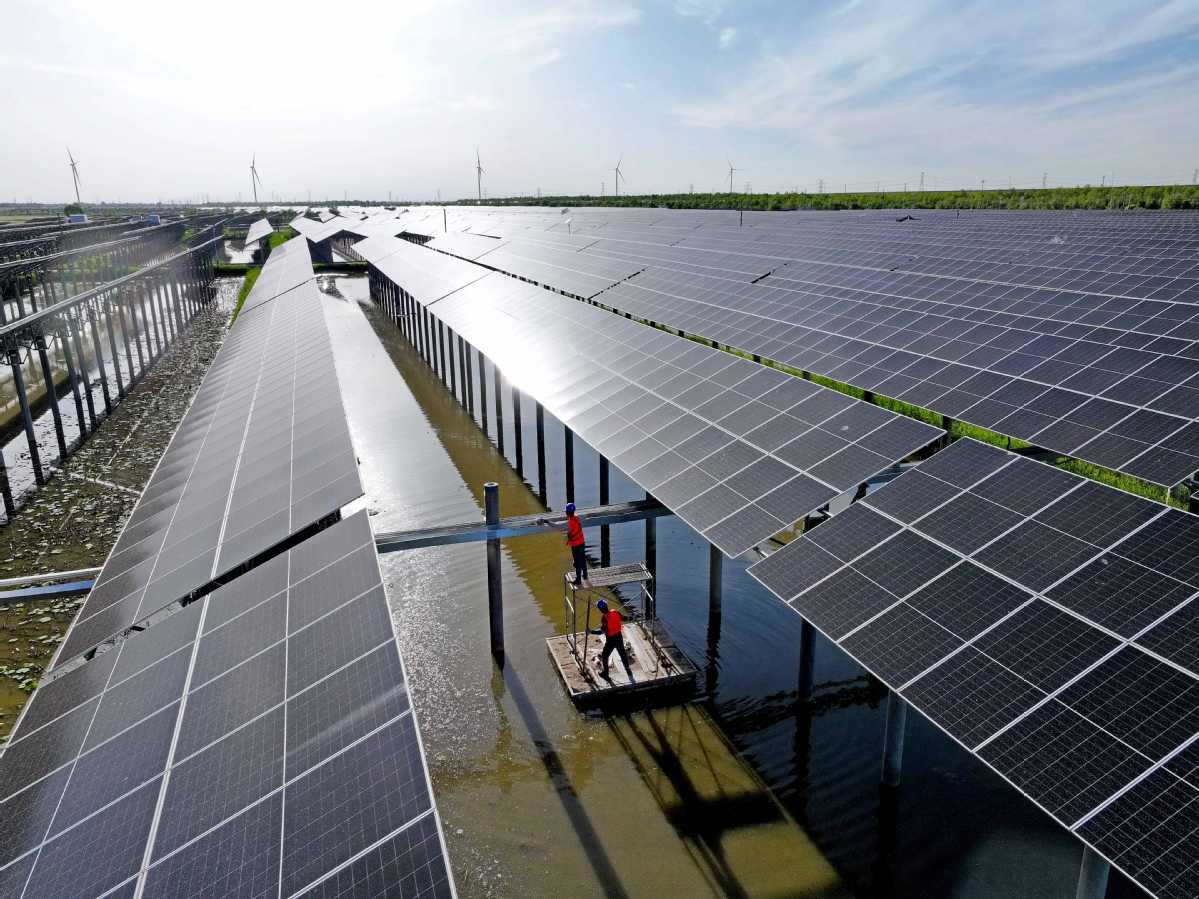
Technicians check photovoltaic panels at a solar power station in Dezhou, Shandong province, in May. ZHANG ZHENXIANG/FOR CHINA DAILY
Chinese energy firms should recalibrate their overseas strategies from mere product exports to establishing local production capacities to explore new avenues for growth amid ongoing trade tensions and geopolitical conflicts, an executive from Ernst & Young (China) told China Daily.
Alex Zhu, energy, infrastructure advisory and carbon neutrality leader of EY China, underscored the importance of strengthening and cultivating collaborative partnerships with local producers. For better cooperation, he also said companies should study policies and their measurable impacts in foreign markets. This understanding facilitates timely adjustments to their international development strategies and business models.
"The key is to expand value chains, share benefits and jointly mitigate risks with local enterprises. This strategic approach prioritizes sustainable market entry and expansion strategies over mere reliance on low-cost sales," he said.
While suggesting Chinese energy firms set up overseas production bases, Zhu emphasized that the move is supported by notable demand from foreign markets where clients favor localized energy production, investments, supply chains and services.
Lin Boqiang, head of the China Institute for Studies in Energy Policy at Xiamen University, said, "Against the backdrop of deglobalization, foreign clients are also shifting their focus from minimizing costs to supply chain security and on-time delivery, thus favoring suppliers capable of producing components and equipment locally, and providing services near their sites."
The China Photovoltaic Industry Association said Chinese companies have announced substantial overseas capacity expansions in recent years. From 2022 to October 2023, plans include over 26 gigawatts of silicon wafer capacity, 60.8 GW of cells and 47.5 GW of modules in Southeast Asia. In the United States, projections include over 19 GW of module capacity and 5 GW of cells. In the Middle East, an emerging PV trade partner with China, plans involve more than 170,000 metric tons of polysilicon, over 50 GW of silicon wafers and 5 GW of cells.
"Chinese energy companies should also enhance technological capabilities and optimize services to increase value. Moreover, further efforts are needed to foster local partnerships to create mutually beneficial ecosystems," Zhu said.
In May, the US government decided to impose additional tariffs on imports of Chinese products including electric vehicles, lithium-ion batteries and solar cells on top of existing tariffs under Section 301 of the US Trade Act of 1974. In particular, the import tax on Chinese solar cells will rise from 25 percent to 50 percent.
On June 12, the European Commission's monthslong antisubsidy investigation into Chinese EVs led to preliminary results proposing extra temporary antisubsidy tariffs of up to 38.1 percent on EV imports from China.
Lin said the additional tariffs show the US is concerned about the rapid growth of the Chinese energy industry, which it sees as a potential threat to US competitiveness.
"Concerns have been heightened in Western nations given the rapid growth of China's solar sector. The advancement of China's PV industry plays a pivotal role in ensuring a stable supply of solar products to address climate change worldwide, making solar power one of the most economical power sources for the vast majority of countries and regions globally," said Liu Yiyang, deputy secretary-general of the CPIA.
Zhu from EY China emphasized the pivotal role of China's energy transition in global efforts to combat climate change and shift toward renewable energy.
"China, as the world's largest producer and consumer of renewable energy, significantly influences the global transition from fossil fuels to renewables across both supply and demand aspects. Leveraging its extensive advantages in the renewable energy supply chain, China excels in providing cost-effective global solutions, effectively alleviating the cost pressures of the global energy transition.
"Additionally, China has accumulated substantial expertise in advancing renewable energy production, power-grid connection, power scheduling and transmission, new energy storage technologies and EVs. China's experiences serve as a valuable reference for other countries and regions," he said.
Looking ahead to the domestic market, Zhu highlighted that China's energy transition this year will focus on overcoming systemic challenges and bottlenecks, particularly in sectors affecting renewable energy's connection to the grid, interprovincial transmission and consumption.
Zhu underscored the urgency to accelerate the development of the electricity market to meet burgeoning consumer demand. Furthermore, Zhu anticipated rapid advancements in emerging sectors such as virtual power plants.
"Digital information technology will continue to empower the energy sector's green transition with further potential for development in fields such as renewable energy's connection to the grid, energy demand response and comprehensive energy services.
"In the past few years, technologies such as big data, artificial intelligence, internet of things and blockchain have been increasingly integrated throughout the energy sector's industry chain — including construction, production, operations and customer service. These innovations not only drastically enhance production efficiency, but also foster the emergence of innovative business models," he said.
Source: By Liu Yukun, chinadaily.com, Jun. 20, 2024 [https://www.chinadaily.com.cn/a/202406/20/WS66737ed5a31095c51c509d3f.html]

